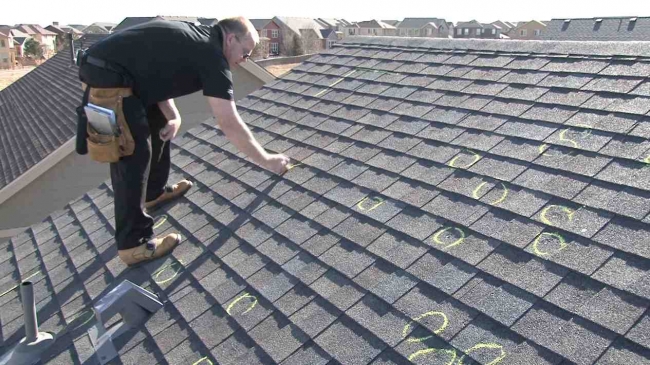How to Identify Hail Damage Roof Inspection Before It’s Too Late
How to Identify Hail Damage Roof Inspection Before It’s Too Late
Blog Article
The Vital Guide to Roof Covering Evaluation: Safeguarding Your Home Versus Typical Damage
Normal roofing assessments are a critical component of home maintenance that can avoid small issues from escalating right into substantial issues. As we check out the common indicators of roof covering damage and reliable upkeep techniques, it comes to be obvious that a positive technique is vital for securing your financial investment.
Significance of Routine Roof Covering Inspections
Routine roof examinations are critical for preserving the integrity of a structure's structure. These evaluations function as a positive procedure to recognize possible concerns prior to they rise right into costly repairs or considerable damages. By carrying out routine assessments, homeowner can guarantee that their roofs stay in ideal problem, therefore lengthening their lifespan.
Throughout these examinations, different factors are evaluated, including the condition of shingles, blinking, and drainage systems. Additionally, the visibility of moss, debris, or algae can be detected, permitting prompt removal. Resolving small issues early on can protect against a lot more extensive issues, such as leakages or structural wear and tear, which may jeopardize the safety and security of the building.
Additionally, regular roofing system evaluations contribute to power effectiveness. A well-kept roof covering decreases heat loss throughout cooler months and reduces the stress on home heating and cooling systems. This, subsequently, can cause lower utility expenses and a minimized carbon footprint.
Typical Indications of Roof Damages
Determining common indications of roof covering damage is vital for house owners to keep the safety and security and long life of their residential or commercial property. One of the most visible indicators is the visibility of missing out on, cracked, or crinkled shingles. These problems can endanger the roofing's integrity, causing leaks and further damage. Additionally, granule loss, usually visible in rain gutters or on the ground, signals that roof shingles are maturing and shedding their protective abilities.
One more crucial indication is water spots on ceilings or walls inside the home, which usually show leakages originating from the roof covering. House owners must also inspect for mold and mildew or mildew development, as these can grow in moist problems caused by roofing leaks.
Blinking around vents and chimneys should be examined for rust or damage, as damaged blinking can enable water to penetrate the roof framework. Drooping areas on the roof covering surface area may suggest architectural issues, requiring instant interest. By acknowledging these signs early, home owners can take proactive measures to address roof covering damages, ultimately guarding their home from costly repairs and making sure a sturdy roof.
Seasonal Roof Covering Maintenance Tips
Identifying the indicators of roof damages is just the primary step in making sure the durability of your roof; ongoing maintenance is similarly vital. Seasonal roof maintenance is vital to not just expand the life of your roofing however likewise to avoid expensive fixings down the line.
Throughout spring, check your roof covering for any signs of winter months damage, such as split roof shingles or displaced blinking. Tidy seamless gutters and downspouts to guarantee appropriate drain. In summertime, check for moss or algae development, and think about using a protective sealant to stop moisture accumulation.
As autumn approaches, get rid of leaves and particles from your roofing and seamless gutters. This will assist reduce the threat of water merging and possible leaks. It's also a great time to take a look at the roofing system for any type of indicators of wear, such as loose shingles or rusted flashing.
Do It Yourself Roofing System Assessment Checklist
A complete DIY roof examination list is necessary for homeowners seeking to maintain the stability of their roof. Begin by taking a look at the roofing surface area for any noticeable indications of damages, such as missing out on, fractured, or curling roof shingles - Hail Damage Roof Inspection. Pay very close attention to areas around vents, skylights, and smokeshafts, as these are common leakage points

Relocating to the interior, inspect the attic room for indicators of water breach, such as spots or mold development. Make certain proper air flow to protect against wetness accumulation, which can cause degeneration.
When to read what he said Employ an Expert,##.
While many home owners can carry out standard roof evaluations, certain scenarios necessitate the knowledge of a professional. If you spot substantial damage, such as huge missing tiles, visible sagging, or water discolorations on the ceiling, it is essential to consult a certified roof covering specialist. These issues may show underlying structural issues that call for immediate interest.
In addition, if your roofing system is nearing completion of its anticipated lifespan-- commonly 20 to 25 years for asphalt shingles-- it is smart to have a specialist evaluation. Experienced inspectors can evaluate the roofing's problem and give enlightened referrals on repair service or substitute.
Serious climate occasions, such as hailstorms or hefty winds, additionally demand specialist analysis. If left untreated, even minor damages can lead to substantial difficulties. Moreover, if you're taking into consideration getting or offering a property, an expert evaluation can uncover potential concerns that may impact the transaction.
Conclusion
Routine roof covering evaluations are crucial for keeping the integrity of domestic frameworks. Focusing on roof evaluations eventually adds to a secure and secure living atmosphere.

During springtime, inspect your roof covering for any kind of indications of winter months damages, such as split shingles or displaced blinking. Begin by checking out the roofing surface for any kind of noticeable signs of damage, such as missing out on, broken, or crinkling roof shingles.
Report this page